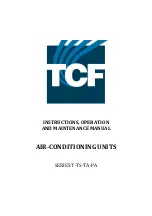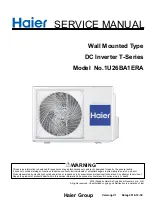
48
English
Instal
lation Pr
oc
edur
e
Insulating the refrigerant pipes and
branch joints
• Check for gas leakage before completing (the hose and pipe
insulation) and if there is no sign of leakage, make sure to
insulate the pipes and hoses.
• Use EPDM material insulator that meets the following
conditions.
Test item
Unit
Standard
Density
g/cm
3
0.048~0.096
Dimensional change rate
by heat
%
Below -5
Absorption rate
g/cm
3
Below 0.005
Thermal conduction rate
W/m·K
Below 0.037
Moisture transpiration
factor
ng/(m
2
·s·Pa)
Below 15
Moisture transpiration
grade
g/(m
2
·24h)
Below 15
Formaldehyde dispersion
mg/L
There should be
none
Oxygen rate
%
Over 25
Selecting the refrigerant pipe insulator
• Insulate the gas pipe and liquid pipe by referring to the
thickness of insulator for each pipe size.
• The standard condition is; temperature at 30°C, humidity less
than 85%. If case if the humidity is higher, you must increase
the size by one grade as stated in below table.
Pipe
Diameter of
refrigerant
pipe
Insulator (Cooling·Heating)
Remarks
General
1)
[30 °C, 85
%]
High
humidity
2)
[30 °C, over
85 %]
EPDM, NBR
Liquid
Ø 6.35 ~
Ø 9.52
9 mm
←
Heat resisting
temperature
over 120°C
Ø 12.7 ~
Ø 50.80
13 mm
←
Gas
Ø 6.35
13 mm
19 mm
Ø 9.52 ~
Ø 25.40
19 mm
25 mm
Ø 28.58 ~
Ø 44.45
32 mm
Ø 50.80
25 mm
38 mm
1)
To install in any of the following places or environments, use the
same insulating material used in general conditions.
–
An air-conditioned place where humidity is high inside the
ceiling tiles
–
A space where temperature/humidity difference is large
between the upper and lower air due to a high ceiling
(e.g., a large chapel/church, cinema, split-level open lobby,
lecture hall with theatre seating)
–
A corridor or passageway with no air conditioning system
–
An old building with poor insulation
[Under the following conditions, a gas pipe of Ø9.52 to Ø25.40
mm and plumbing of 13 t can be used]
–
A general town centre building (e.g., an apartment
building, dwelling house, lecture hall, educational institute
building, office, shopping complex)
–
A structure with an exposed ceiling
–
A structure with ceiling tiles and a ventilation system
–
A structure where there is no inflow of air from the outside
due to plumbing laid inside a wall
※
Even in the above conditions, if humidity is very high or
condensation is expected to occur, change the installation
thickness for high humidity.
2)
To install in any of the following places or environments, use the
same insulating material used in a place with high humidity.
<Geographical conditions>
–
A location with high humidity, such as a seaside area, a hot
spring area, an area near a pond/river or a ridge (a building
that is partially covered in earth and sand)
–
A location where morning dew occurs frequently (e.g., once
every three days)
<Purpose of the building>
–
Sauna, swimming pool or restaurant
<Structural conditions of the building>
–
Installation inside a ceiling that is not air-conditioned
where there is inflow of a large amount of moisture
(plumbing installed along a corridor or near the entrance
of a hall of residence or studio flat)
–
A place where humidity is high due to an insufficient
ventilation system in the space where plumbing is installed
–
A room on a semi-basement floor
• If you are not sure which insulating material to use, choose
material used in a place with high humidity.
• If the purpose of the room is subject to change, reconsider the
thickness of insulating material.
• Use the specified insulating material only.
Insulate the refrigerant pipe
• Make sure to insulate the refrigerant pipe, branch joint,
distribution header, and the connection part of the pipes.
• If you insulate the pipes, condensed water will not fall from the pipes.
• Check if there are any cracks on the insulation at the bent part
of the pipe.
Insulator
Clamp
Liquid side pipe
Gas side
pipe
Insulator
Fix securely without any gap.
Install the insulation to be overlapped
Indoor unit
Insulator
Pipe insulation
Содержание AM AXV Series
Страница 68: ......
















































